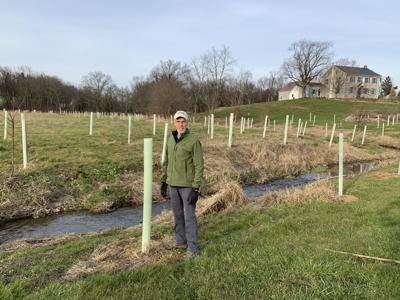As Dellinger Run wends its way toward Chiques Creek, it stretches through 56 acres of farmland in Rapho Township, where owner Mark Heller enjoys watching the ducks and fish that swim in the stream.
But wildlife hasn’t always been so plentiful in the waters that cut Heller’s produce operation in two. The stream, he said, had been in an unhealthy state for years.
Erosion was a big problem, according to Heller, who said it was exacerbated during heavy storms.
“It was always shifting in position,” he said of the stream’s course.
That was before Heller was approached by clean water experts at Penn State University who connected him with funding and advice on how to restore stream banks and add forested streamside buffers.
It’s work Heller said he had long wanted to complete but was unable to do on his own due to costs.
With more than $1 million in new funds, Penn State experts are again targeting the Chiques Creek Watershed, as well as the nearby Conoy and Conewago watersheds.
The new program, called the Chiques-Conoy-Conewago Regional Partnership (or C3RP for short), is intended to clean the water in local streams while also helping to fulfill a federal mandate to reduce pollution flowing downstream to the Chesapeake Bay. That’s according to officials at Lancaster Clean Water Partners, a countywide group of organizations working toward those goals.
“The C3RP is a great project that demonstrates the collaborative spirit of Lancaster County and highlights the necessity to collaborate and coordinate in order to reach such an extraordinary goal of clean and clear water in 2040,” said Allyson Gibson, Lancaster Clean Water Partners coordinator.
The C3RP partners will be looking to make environmental upgrades on agricultural land, especially those bordered by steams, according to Lauren Shaffer, an outreach specialist with Penn State’s Agriculture and Environment Center.
The targeted watersheds are considered impaired, and all three flow into the Susquehanna River, which, in turn, empties into the Chesapeake Bay.
“In the bay watershed, farms are the biggest contributor of nutrient runoff into our waterways and Lancaster County is the biggest offender in Pennsylvania,” Shaffer said.
Federal regulators have mandated that runoff pollution be reduced. In Lancaster County, that means eliminating millions of pounds of sediment and nutrients from entering local waterways and washing south to the bay, where they can foster algae blooms that deplete oxygen from its waters.
A large portion of the funding available to the C3RP effort, Shaffer said, will be used to implement runoff capturing buffer planting and stream improvements. That’s in addition to boosting other on-farm conservation practices, including transitions to no-till planting and cover-crop practices, as well as better manure and nutrient management plans.
Penn State officials want C3RP to add 75 acres of forested buffers, restore 7,500 feet of stream and implement soil health practices across 1,360 acres, according to a related grant document.
They’re similar practices to the ones that led to visible improvements on Heller’s farm, starting in 2018 under a previous Penn State initiative, he said. It was enough to inspire him to keep up the work, continuing tree-planting with a pair of friends this winter.
“I don’t mind contributing to this,” Heller said, pleased with the progress.
Measurable improvements were also achieved by similar work in parts of the Conewago Creek watershed. There, sampling found that pollution-sensitive macroinvertebrates, specifically aquatic insects, are making a comeback, said Matt Royer, director of Penn State’s Agriculture and Environment Center.
Royer said he’s hopeful the same will be true in the C3RP priority watersheds after on-farm projects are completed. But for now, program leaders mostly are in an outreach phase, simply working to build relationships with landowners in the targeted area, which also includes parts of neighboring Dauphin and Lebanon counties.
“It is around 1,200 to 1,300 individual farm owners,” Royer said.
Related funding, which must be spent by 2022, will be doled out to qualifying landowners on a first-come, first-serve basis, Shaffer said.
“We are prioritizing outreach and funding for farms with streams [that] have the greatest resource concerns,” she said.
That doesn’t mean the absence of a stream will disqualify a farm.
“Even though a farm may not have a stream on their property, they are still located within a watershed and runoff will end up in local waterways at some point,” Shaffer said. “Conservation practices on any farm, stream or no stream, can help improve soil and herd health as well as crop yields in some cases, and being a steward of farmland still can help the environment overall.”
Recently, officials approved the first application to the C3RP program, Shaffer said, unable to share specific details.
“It will include significant improvements, so we are excited for it to be a starting point for the program,” she said.
Farmers in the targeted area who are interested in the program can email las6435@psu.edu or call 717-364-2044 to get more information, Shaffer said.


 SEAN SAURO | Staff Writer
SEAN SAURO | Staff Writer

